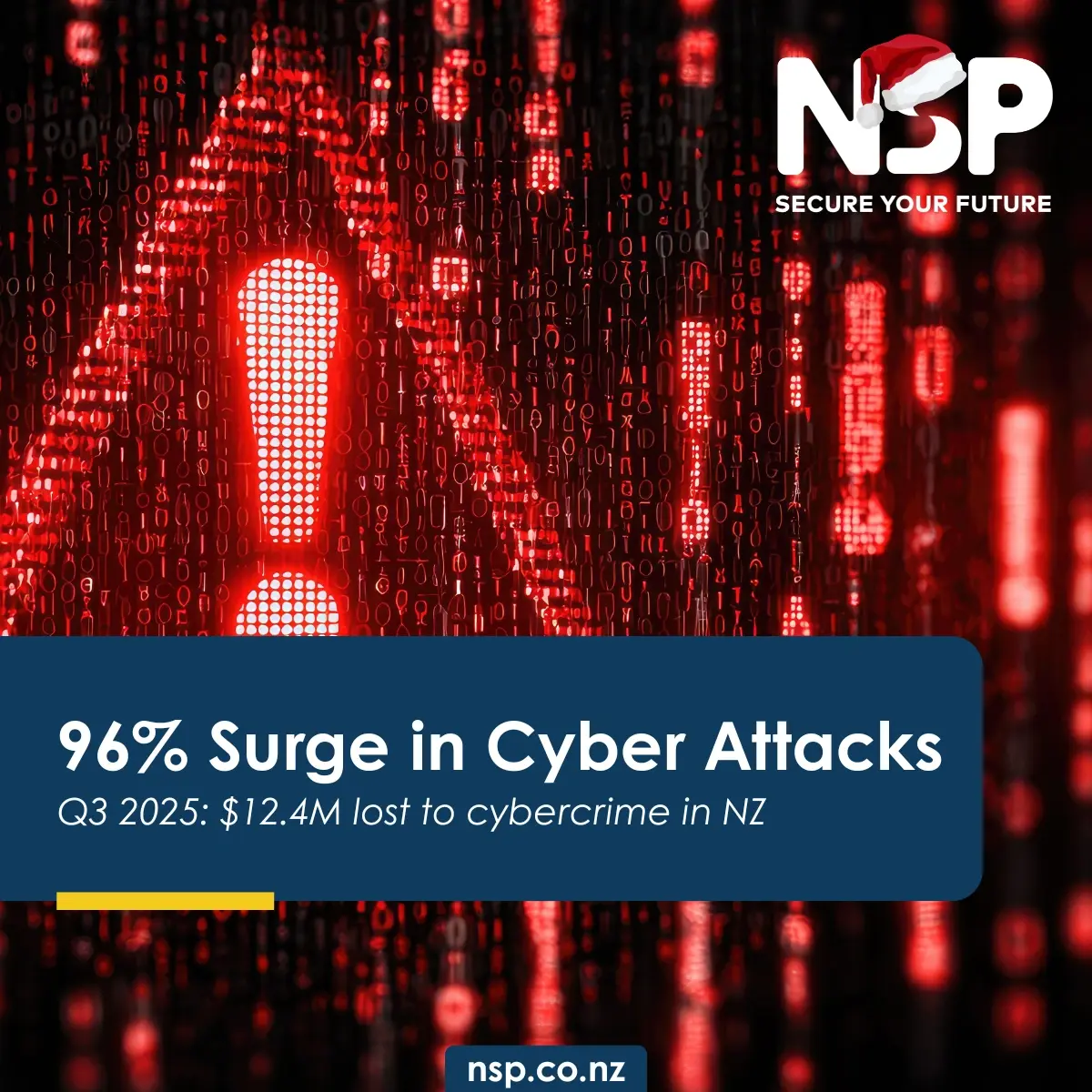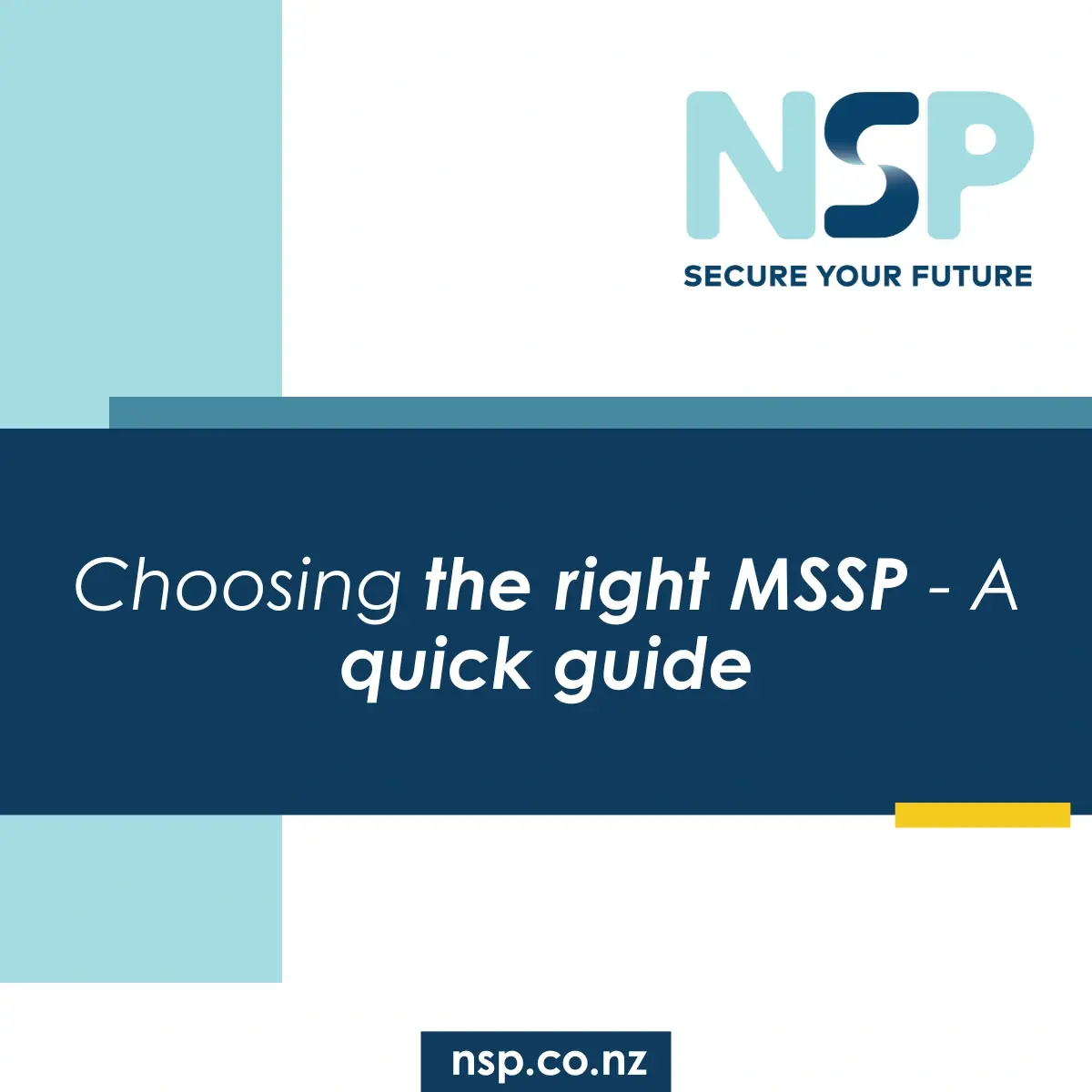Managed Detection & Response: Why NZ SMEs Can’t Wait
Dayna-Jean Broeders
15 September 2025
10 min
ReadDon’t wait for a breach: Why New Zealand SMEs need MDR
The perfect storm facing NZ SMEs
In New Zealand, small and medium-sized enterprises (SMEs) are now firmly in the crosshairs of cybercriminals. The National Cyber Security Centre reports that 53% of SMEs experienced a cyber incident in the past 12 months, up 36% from the year before.
What’s driving this rise? Attackers know SMEs often lack dedicated security teams, rely heavily on cloud platforms like Microsoft 365, and believe they’re “too small to target.” The reality is that ransomware-as-a-service and credential theft campaigns thrive on volume, and SMEs represent fast wins with weaker defences.
This creates a perfect storm: more sophisticated attacks, more regulation, and more pressure on lean IT teams. Against this backdrop, Managed Detection & Response (MDR) is the missing layer of security that ensures threats are detected early and neutralised before they become a crisis.
MDR explained: The defence SMEs can’t afford to ignore
So, what exactly is MDR?
Managed Detection & Response (MDR) is a cybersecurity service that combines advanced technology, human expertise, and 24/7 monitoring to detect and respond to threats in real time.
Where traditional tools like antivirus and firewalls wait for known signatures, MDR continuously hunts for unusual behaviours, investigating anomalies and acting when needed. It doesn’t just sound an alarm, it contains attacks before they cause damage.
Key functions of MDR include:
-
Continuous monitoring: Around-the-clock surveillance of endpoints, servers, and cloud services.
-
Threat hunting: Proactive searches for hidden threats that bypass automated tools.
-
Incident response: Immediate containment and remediation when a breach attempt occurs.
-
Guidance: Insights and recommendations to improve overall resilience.
To understand MDR’s value, it helps to see how it compares to other common security approaches:
-
EDR (Endpoint Detection & Response): Focuses only on endpoints; requires in-house expertise.
-
SIEM (Security Information & Event Management): Collects logs but doesn’t investigate or respond.
-
SOC (Security Operations Centre): A function, not a service. Building your own SOC is expensive and complex.
-
MDR: Offers enterprise-grade SOC capabilities as a managed service, ideal for SMEs.
In short, MDR gives SMEs the benefits of a dedicated security team without the overhead of building one internally.
Outdated defences leave the door wide open
Many SMEs in New Zealand still rely on the “old guard” of security: antivirus, firewalls, and ad hoc IT support. While these are necessary, they’re no longer enough to withstand today’s attacks.
Common attack vectors hitting NZ SMEs include:
-
Phishing and Business Email Compromise (BEC): Fraudulent emails tricking staff into transferring funds or sharing login details. A growing issue in law firms and real estate, where transactions are high-value.
-
Credential theft: Stolen usernames and passwords from dark web breaches used to infiltrate cloud services like Microsoft 365.
-
Ransomware-as-a-service: Pre-packaged ransomware kits sold online, making attacks cheaper and more frequent.
-
Supply chain compromise: SMEs targeted as entry points into larger partners or clients.
The hidden cost of ignoring MDR
The cost of a breach extends far beyond paying a ransom.
Tangible costs:
-
Ransom demands: Commonly between $50k-$500k for SMEs
-
Downtime: Average recovery time from ransomware is 21 days.
-
Recovery expenses: Forensic investigations, IT rebuilds, legal fees.
Intangible costs:
-
Reputation damage: Clients lose trust when their data is exposed. In sectors like law and real estate, that trust is your business.
-
Compliance penalties: Under the NZ Privacy Act, organisations must notify affected customers and the Privacy Commissioner of data breaches. Failure to do so risks penalties and legal action.
-
Insurance exposure: Cyber insurers increasingly require MDR or equivalent as proof of active defence. Without it, claims may be denied. (ask us about our Cyber Insurance Assessment Services)
When you weigh these costs against the monthly investment in MDR, the ROI becomes clear. For most SMEs, MDR costs a fraction of what a single breach could cost, making it not just an IT decision, but a financial and risk management imperative.
MDR in action: How it shields your business
MDR is best understood in terms of its lifecycle response to threats:
-
Monitoring & telemetry collection - Every system, from endpoints to email, is continuously monitored for unusual activity.
-
Threat hunting - Analysts use threat intelligence and behavioural analytics to proactively search for hidden risks.
-
Incident triage & escalation - Suspicious activity is investigated, with false positives filtered out by human experts.
-
Rapid response - Confirmed threats are contained immediately, whether isolating a device, disabling a compromised account, or blocking malicious traffic.
-
Root cause analysis & hardening - After the incident, businesses receive a full report and recommendations to strengthen defences.
Example scenario:
At 3am, an attacker attempts to use stolen credentials to log in to a law firm’s Microsoft 365 account from offshore. The login bypasses MFA using a token hijack technique. MDR flags the unusual location and behaviour, investigates within minutes, and automatically blocks the session. Analysts then advise the client to reset credentials, review audit logs, and enable additional controls. The breach attempt is stopped before a single email is accessed.
This is the power of MDR: catching what automated systems miss and responding in real time.
What is Europe doing? Why MDR Adoption is Surging
New Zealand is not alone in facing rising cyber threats. In Europe, MDR adoption has surged in recent years, driven by regulation and business necessity.
-
GDPR compliance: European SMEs must demonstrate active protection of personal data. MDR supports this by ensuring continuous monitoring and rapid breach response.
-
NIS2 directive: Expands cybersecurity requirements to more sectors, making MDR the simplest path to compliance.
-
Insurance requirements: Many cyber insurers now require MDR as a condition of coverage (Explore NSP's Cyber Insurance Assessment services)
The lesson for New Zealand SMEs is that regulation and insurer expectations will only get stricter here too. Forward-thinking businesses are already adopting MDR to stay ahead, rather than scrambling later.
What sets NSP’s MDR apart in New Zealand
Not all MDR providers are equal. At NSP, we’ve built our MDR service specifically for New Zealand SMEs.
-
Local expertise & local data: We are a 100% NZ owned business. All monitoring and analysis is handled by NZ-based teams who understand local threat trends. Your data stays here.
-
Microsoft-certified specialists: With most SMEs running Microsoft 365 or Azure, our team provides unmatched integration and defence across your ecosystem.
-
Human-driven detection: Automation does the heavy lifting, but our analysts apply human judgement to know what’s truly suspicious for your business.
-
Flexible engagement models: Fully managed, co-managed, or advisory, designed to fit businesses of different sizes and cyber maturity levels.
-
Aligned with global frameworks: Our MDR is grounded in NIST, Zero Trust, and layered defence principles, giving SMEs confidence in world-class security practices.
Whether you’re a 20-person startup or a 200-staff law firm, NSP delivers the right level of MDR to protect your future.
The business case for MDR: ROI and peace of mind
Cybersecurity is often seen as a cost centre but MDR flips that perception, it’s an investment in resilience.
Consider the numbers:
-
MDR costs a fraction of building your own SOC (which would require analysts, tools, and 24/7 coverage).
-
Cyber insurance premiums drop when you demonstrate MDR is in place.
-
The financial and reputational damage of one breach can sink an SME.
But ROI is more than money. MDR gives:
-
Boards and owners confidence that risks are managed.
-
Employees assurance that their work environment is safe and stable.
-
Clients trust that their data is secure, a competitive advantage in industries where trust is everything.
The time to act is before the attack
Cyberattacks are not slowing down, in fact, they’re becoming faster, smarter, and more frequent. For SMEs, the question is no longer if an incident will happen, but when.
MDR ensures you’re ready, with real-time detection, rapid response, and expert guidance. It transforms cybersecurity from reactive firefighting into proactive resilience.
At NSP, we’ve seen MDR protect New Zealand SMEs across all industries, including law, real estate, and startups, with fewer incidents, faster recovery, stronger compliance, and greater peace of mind.
Don’t wait until after a breach to take action. Book your free consultation with NSP today and discover how MDR can safeguard your business.
FAQs: Managed Detection & Response for NZ SMEs
1. How is MDR different from antivirus or firewalls?
Antivirus and firewalls defend against known threats. MDR proactively hunts for both known and unknown attacks, combining automation with human analysis.
2. Isn’t MDR too expensive for small businesses?
MDR is designed to be scalable. For SMEs, it’s far more affordable than building an internal security team, and far cheaper than the cost of a breach.
3. How fast does MDR respond to an incident?
NSP’s SOC operates 24/7. When a threat is confirmed, containment actions are immediate, reducing downtime and impact.
4. Does MDR help with compliance in NZ?
Yes. MDR supports obligations under the Privacy Act and strengthens your position with auditors, clients, and insurers.
5. Does MDR protect cloud services like Microsoft 365?
Absolutely. NSP’s MDR includes cloud monitoring, ensuring services like Microsoft 365 and Azure are continuously protected.
6. What’s the difference between MDR and a SOC?
A SOC is the team and tools required to monitor and respond to threats. MDR delivers SOC capabilities as a managed service, no need for you to build one.
7. Can MDR stop ransomware before it encrypts data?
Yes. By detecting unusual behaviours early (like lateral movement or suspicious file changes), MDR can stop ransomware before full encryption.
8. How does MDR improve my cyber insurance position?
Insurers increasingly expect MDR. Having it in place often reduces premiums and ensures claims are more likely to be honoured. NSP can also help you with your Cyber Insurance application
9. How quickly can an SME get MDR set up?
Most SMEs can be onboarded to NSP’s MDR service in weeks, with minimal disruption to existing IT operations.
CATEGORY
- Article (98)
- Cybersecurity (44)
- Cyber Security (38)
- Digital transformation (31)
- Managed services (29)
- Awareness and education (23)
- Cloud (20)
- IT Risk (14)
- modern workplace (12)
- Collaboration (11)
- Cyber Smart Week (11)
- Breach (9)
- microsoft (9)
- AI (8)
- Backup (8)
- Remote Workers (8)
- copilot (7)
- video (7)
- Future of work (6)
- network performance (6)
- Vulnerability Assessment (5)
- Breech (4)
- Business strategy (4)
- Cyber (4)
- Microsoft Teams (4)
- 0365 (3)
- CISO (3)
- Culture (3)
- Best Practice (2)
- Business Goals (2)
- CASB (2)
- CIO (2)
- COVID-19 (2)
- Charity (2)
- Construction Industry (2)
- Feed the Need (2)
- Friction-less (2)
- Governance (2)
- Managed Detection & Response (MDR) (2)
- Penetration Testing (2)
- Tabletop Exercise (2)
- vCISO (2)
- Assets (1)
- Azure (1)
- BYOD (1)
- Christmas (1)
- Co-pilot (1)
- Deserving Family (1)
- E-Waste (1)
- EPP (1)
- Healthcare (1)
- IT budget (1)
- KPI (1)
- Law Industry (1)
- Legal Industry (1)
- Metrics (1)
- News (1)
- Real Estate Industry (1)
- Restore (1)
- artificial intelligence (1)
- case study (1)
- health IT consultant (1)
- health it (1)
RECENT POST
Let’s stay in touch!
Enter your details below to stay up-to-date with the latest IT solutions and security measures.




.webp)